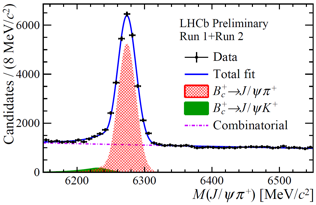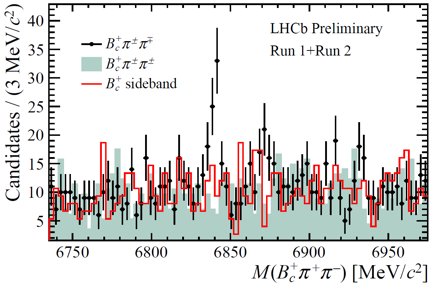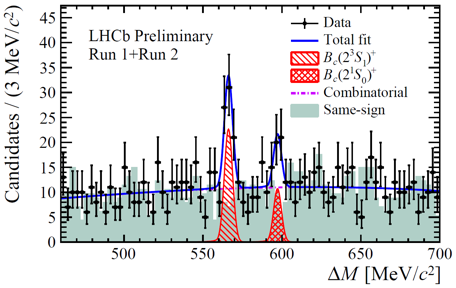Observation of an excited Bc+ state.
This week the LHCb collaboration announced the observation of an excited Bc+ state, confirming measurements by the ATLAS and CMS collaborations. The results were presented at the conference “Rencontres de Physique de la Vallée d’Aoste” held at La Thuile, Italy.
The Bc+ particle is a very interesting meson composed of two different heavy quarks: an anti-beauty quark (electric charge +1/3) and a charm quark (+2/3) bound together by the strong nuclear force. Just like ordinary atoms, c and b quarks can be arranged in various quantum states with different angular momenta and spin configurations, giving rise to a spectrum of particles with different masses like charmonium and bottomonium systems. The charmonium, cc, and bottomonium, bb, quark bound systems were intensively studied after the discovery of the J/ψ meson on 11 November 1974. (Indeed, LHCb continues to contribute to these studies; see a recent contribution in the news below). The study of the Bc+ system, cb, is much more difficult. Bc+ mesons are produced much more rarely, since both a cc and a bb quark pair need to be formed close together. But at the LHC, the large energy and intensity of pp collisions allow sufficient number of Bc+ mesons to be produced, enabling scientists to study the properties of the cb quark bound system.
Bc+ mesons are unstable, but they can be reconstructed by looking for their decay products. In the first step of the analysis, LHCb physicists looked for pairings of a J/ψ and a π+ meson, one possible Bc+ decay mode. The image shows the corresponding invariant mass spectrum. The points with error bars are the data, and the red cross-hatched area shows a clear contribution from the decays of the Bc+ ground state: the lowest-mass state of the cb system. (The ground state is sometimes just called the Bc+.)
In the second step of analysis, the physicists looked for signs of strong decays of excited Bc+ mesons to the ground state. To do this, they looked for combinations of the Bc+ ground-state meson plus a pair of opposite sign pions, π+π–. The left image below shows the corresponding invariant mass spectrum, with the black points showing the mass of Bc+π+π– combinations: two peaking structures are visible. The same image also includes a red histogram; this represents combinations of a Bc+ with two same-sign points, e.g. Bc+π+π+. Because these same-sign combinations have the wrong electric charge, they cannot contain real excited Bc+ states and are useful as a measure of the background. The right image below is made from the same data sample but plotted in a different way: the x-axis variable, ΔM, is obtained by subtracting the Bc+ meson mass from the Bc+π+π– invariant mass. The two coloured peaks show the contributions of the two excited states announced at the conference today: the left one (red hatched) is observed with a significance above 5σ while the right one (red cross-hatched) has a local significance above 3σ. The numerical results of the measurements can be found in the LHCb presentation.
What are these structures? The four relevant quantum states of the cb system are show in the image to the left. Like many systems in atomic, nuclear, and particle physics, angular momentum plays a key role. The energy of the system is determined by three quantities: the spin arrangement of the c and b quarks, the angular momentum between the quarks, and the radial excitation (size) of the system. Each of the four states shown is marked “S”, meaning that there is zero orbital angular momentum between the quarks. There are two main levels: a ground state 1S and an excited state 2S. Within each of those two levels, the quarks can be arranged so that their spins are opposed (↑↓) or aligned (↑↑). Since each quark has spin ½, these correspond to total spins of 0 or 1; like when putting bar magnets side by side, the arrangement with opposed spins is more stable and corresponds to a lower-mass state. The two peaks seen by LHCb are due to the two decays of a 2S excited state to a 1S ground state (2S0→1S0 and 2S1→1S1) accompanied by a pair of pions (π+π–), shown as vertical black arrows in the figure. For the 2S1 decay chain, there is an extra photon produced (marked γ, from the transition (1S1→1S0 at the bottom of the figure) but it is not reconstructed.
There is a correspondance between the four cb states shown in the image and the charmonium states ηc(1S), ηc(2S), J/ψ and ψ(2S) shown in the schema in the recent LHCb news below. The cb state 1S1, corresponding to the J/ψ meson in this analogy, has not yet been observed directly.
The Bc+ meson was first observed by the CDF collaboration at the Tevatron collider in 1998. The ATLAS collaboration first reported a single peak in the Bc+π+π– invariant mass distribution in 2014, but due to experimental limitations on the mass resolution and signal yield the ATLAS analysis was unable to resolve the two-peak structure. One month ago, in February 2019, the CMS collaboration released a paper in which the two peak structure is resolved. The LHCb and CMS results for the properties of the peaks are consistent.
Properties of the Bc meson family can reveal information on heavy quark dynamics and improve the understanding of the strong interaction in the intermediate energy region between charmonium and bottomonium. The two –onium systems have been studied for 40 years. The precise study of Bc meson family, the cb system, starts now. The LHCb experiment at the LHC is very well designed to play a leading role in this investigation.
Read more in the LHCb presentation and in the LHCb paper.




